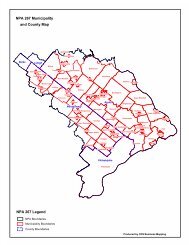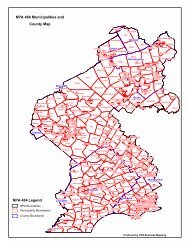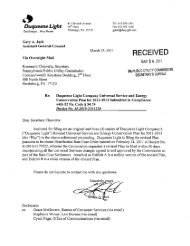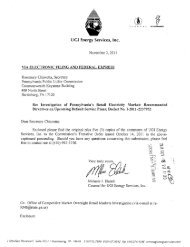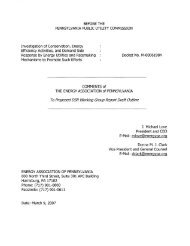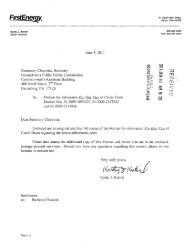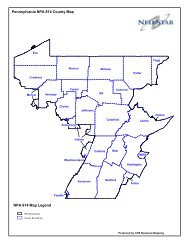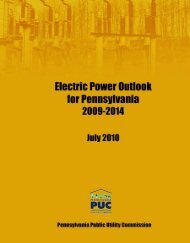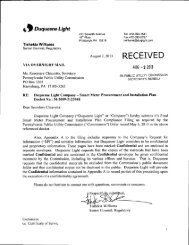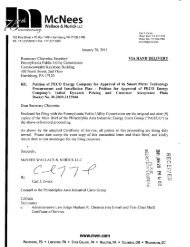METROPOLITAN EDISON COMPANY - Pennsylvania Public Utility ...
METROPOLITAN EDISON COMPANY - Pennsylvania Public Utility ...
METROPOLITAN EDISON COMPANY - Pennsylvania Public Utility ...
- No tags were found...
Create successful ePaper yourself
Turn your PDF publications into a flip-book with our unique Google optimized e-Paper software.
X. HUMAN RESOURCESBackground – The Stratified Management and Operations Audit of Metropolitan EdisonCompany (Met-Ed), <strong>Pennsylvania</strong> Electric Company (Penelec), and <strong>Pennsylvania</strong>Power Company (Penn Power) (collectively referred to as the FirstEnergy <strong>Pennsylvania</strong>Companies or FE-PA Companies), conducted by the consulting firmBarrington-Wellesley Group, Inc. (BWG or Consultant), released by the <strong>Pennsylvania</strong><strong>Public</strong> <strong>Utility</strong> Commission (PUC or Commission) on March 1, 2007, at D-05MGT002,D-05MGT003 and D-05MGT004, contained eight recommendations in the HumanResources chapter. BWG rated this functional area as needing minor improvement. Inthis chapter, four prior recommendations and prior situations are reviewed and fourfollow-up findings and four recommendations are presented.Prior Recommendation – Examine employee staffing levels at all FirstEnergy<strong>Pennsylvania</strong> operating companies in order to ensure that staffing levels for allemployee groups are appropriate.Prior Situation – FirstEnergy Corp. (FirstEnergy) employed 13,442 employees at theend of 2005, compared to over 15,000 in 2000 (a 10% decrease in five years) whilestaffing levels for the FE-PA Companies increased by approximately 8%. Despite theincrease in staffing levels, BWG was concerned that the FE-PA Companies may havebeen understaffed. The ratio of union to non-union employees at all three FE-PACompanies was less than 3:1 which indicated that the increase likely occurred in thenon-union ranks. BWG also found that many of FirstEnergy’s spans of control ratioswere 1:4 or less, which was outside the generally accepted sound business practicerange of 1:5 to 1:7.The FE-PA Companies experienced a substantial loss of employees from 2001to 2005 primarily through retirements. Approximately 67% of personnel that leftFirstEnergy from 2000 through 2005 retired, resignations accounted for approximately16% and terminations and severances accounted for another 16% of departures. Forthe FE-PA Companies, the ratio of customers to employees increased by almost 20%(i.e., 80.3 to 94.6) from 2000 to 2005. FirstEnergy had employed a substantial numberof contract workers in 2005. Thus the Consultant recommended that any examinationof staffing levels include a review of contractor staffing.Follow-up Finding and Conclusion No. X-1 – FirstEnergy examined employeestaffing levels at the FE-PA Companies, but analyses of contractor staffing levelsand spans of control were not performed.In 2007, FirstEnergy engaged a consultant to perform a Workload and ManpowerPlanning Analysis. One of the recommendations resulting from this analysis was totrack contractor productivity. FirstEnergy strives to ensure contractor productivity,performance and conformance with the contract provisions through oversight andmonitoring by the project manager throughout the contract period. Amounts paid tocontractors by the FE-PA Companies from 2007 to 2009 are shown in Exhibit X-1. The- 62 -



